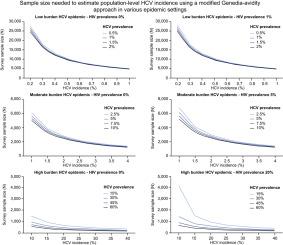当前位置:
X-MOL 学术
›
J. Hepatol.
›
论文详情
Our official English website, www.x-mol.net, welcomes your
feedback! (Note: you will need to create a separate account there.)
Antibody avidity-based approach to estimate population-level incidence of hepatitis C
Journal of Hepatology ( IF 26.8 ) Pub Date : 2020-08-01 , DOI: 10.1016/j.jhep.2020.03.028 Denali Boon 1 , Veronica Bruce 2 , Eshan U Patel 1 , Jeffrey Quinn 1 , Aylur K Srikrishnan 3 , Saravanan Shanmugam 3 , Syed Iqbal 3 , Pachamuthu Balakrishnan 3 , Matthew Sievers 1 , Gregory D Kirk 1 , David L Thomas 1 , Thomas C Quinn 4 , Andrea L Cox 1 , Kimberly A Page 2 , Sunil S Solomon 5 , Shruti H Mehta 1 , Oliver Laeyendecker 4
Journal of Hepatology ( IF 26.8 ) Pub Date : 2020-08-01 , DOI: 10.1016/j.jhep.2020.03.028 Denali Boon 1 , Veronica Bruce 2 , Eshan U Patel 1 , Jeffrey Quinn 1 , Aylur K Srikrishnan 3 , Saravanan Shanmugam 3 , Syed Iqbal 3 , Pachamuthu Balakrishnan 3 , Matthew Sievers 1 , Gregory D Kirk 1 , David L Thomas 1 , Thomas C Quinn 4 , Andrea L Cox 1 , Kimberly A Page 2 , Sunil S Solomon 5 , Shruti H Mehta 1 , Oliver Laeyendecker 4
Affiliation

|
BACKGROUND & AIMS
Accurate hepatitis C virus (HCV) incidence estimates are critical for monitoring progress towards HCV elimination goals, including an 80% reduction in HCV incidence by 2030. Moreover, incidence estimates can help guide prevention and treatment programming, particularly in the context of the US opioid epidemic. METHODS
An inexpensive, Genedia-based HCV IgG antibody avidity assay was evaluated as a platform to estimate cross-sectional, population-level primary HCV incidence using 1840 HCV antibody and RNA positive samples from 875 individuals enrolled in 5 cohort studies in the US and India. Using samples collected <2 years following HCV seroconversion, the mean duration of recent infection (MDRI) was calculated by fitting a maximum likelihood binomial regression model to the probability of appearing recent. Among samples collected ≥2 years post-HCV seroconversion, a subject-level false recent ratio (FRR) was calculated by estimating the probability of appearing recent using an exact binomial test. Factors associated with falsely appearing recent among samples collected ≥2 years post seroconversion were determined by Poisson regression with generalized estimating equations and robust variance estimators. RESULTS
An avidity index cutoff of <40% resulted in an MDRI of 113 days (95%CI:84-146), and an FRR of 0.4% (95%CI:0.0-1.2), 4.6% (95%CI:2.2-8.3), and 9.5% (95%CI:3.6-19.6) among persons who were HIV-uninfected, HIV-infected, and HIV-infected with a CD4 count <200, respectively. No variation was seen between HCV genotypes 1 and 3. In hypothetical scenarios of high-risk settings, a sample size of <1000 individuals could reliably estimate primary HCV incidence. CONCLUSIONS
This cross-sectional approach can estimate primary HCV incidence for the most common genotypes. This tool can serve as a valuable resource for program and policy planners seeking to monitor and reduce HCV burden.
中文翻译:

基于抗体亲和力的方法估计丙型肝炎的人群水平发病率
背景和目的 准确的丙型肝炎病毒 (HCV) 发病率估计对于监测消除 HCV 目标的进展至关重要,包括到 2030 年将 HCV 发病率降低 80%。此外,发病率估计可以帮助指导预防和治疗规划,特别是在以下情况下美国阿片类药物流行。方法 一种廉价的、基于 Genedia 的 HCV IgG 抗体亲和力测定被评估为一个平台,使用来自美国和印度的 5 个队列研究的 875 名个体的 1840 个 HCV 抗体和 RNA 阳性样本来估计横断面、人群水平的原发性 HCV 发病率. 使用在 HCV 血清转化后 2 年内收集的样本,通过将最大似然二项式回归模型拟合到最近出现的概率来计算最近感染的平均持续时间 (MDRI)。在 HCV 血清转换后 2 年以上收集的样本中,通过使用精确二项式检验估计最近出现的概率来计算受试者水平的虚假近期比率 (FRR)。与在血清转换后≥2 年收集的样本中错误出现最近相关的因素由泊松回归确定,该回归具有广义估计方程和稳健的方差估计量。结果 <40% 的亲和力指数临界值导致 113 天的 MDRI (95%CI:84-146),FRR 为 0.4% (95%CI:0.0-1.2)、4.6% (95%CI:2.2) -8.3) 和 9.5% (95%CI:3.6-19.6) 在 CD4 计数 <200 的未感染 HIV、感染 HIV 和感染 HIV 的人群中分别发生。在 HCV 基因型 1 和 3 之间没有观察到差异。在高风险环境的假设情景中,样本量 < 1000 个人可以可靠地估计原发性 HCV 发病率。结论 这种横断面方法可以估计最常见基因型的原发性 HCV 发病率。该工具可为寻求监测和减轻 HCV 负担的计划和政策规划者提供宝贵的资源。
更新日期:2020-08-01
中文翻译:

基于抗体亲和力的方法估计丙型肝炎的人群水平发病率
背景和目的 准确的丙型肝炎病毒 (HCV) 发病率估计对于监测消除 HCV 目标的进展至关重要,包括到 2030 年将 HCV 发病率降低 80%。此外,发病率估计可以帮助指导预防和治疗规划,特别是在以下情况下美国阿片类药物流行。方法 一种廉价的、基于 Genedia 的 HCV IgG 抗体亲和力测定被评估为一个平台,使用来自美国和印度的 5 个队列研究的 875 名个体的 1840 个 HCV 抗体和 RNA 阳性样本来估计横断面、人群水平的原发性 HCV 发病率. 使用在 HCV 血清转化后 2 年内收集的样本,通过将最大似然二项式回归模型拟合到最近出现的概率来计算最近感染的平均持续时间 (MDRI)。在 HCV 血清转换后 2 年以上收集的样本中,通过使用精确二项式检验估计最近出现的概率来计算受试者水平的虚假近期比率 (FRR)。与在血清转换后≥2 年收集的样本中错误出现最近相关的因素由泊松回归确定,该回归具有广义估计方程和稳健的方差估计量。结果 <40% 的亲和力指数临界值导致 113 天的 MDRI (95%CI:84-146),FRR 为 0.4% (95%CI:0.0-1.2)、4.6% (95%CI:2.2) -8.3) 和 9.5% (95%CI:3.6-19.6) 在 CD4 计数 <200 的未感染 HIV、感染 HIV 和感染 HIV 的人群中分别发生。在 HCV 基因型 1 和 3 之间没有观察到差异。在高风险环境的假设情景中,样本量 < 1000 个人可以可靠地估计原发性 HCV 发病率。结论 这种横断面方法可以估计最常见基因型的原发性 HCV 发病率。该工具可为寻求监测和减轻 HCV 负担的计划和政策规划者提供宝贵的资源。











































 京公网安备 11010802027423号
京公网安备 11010802027423号